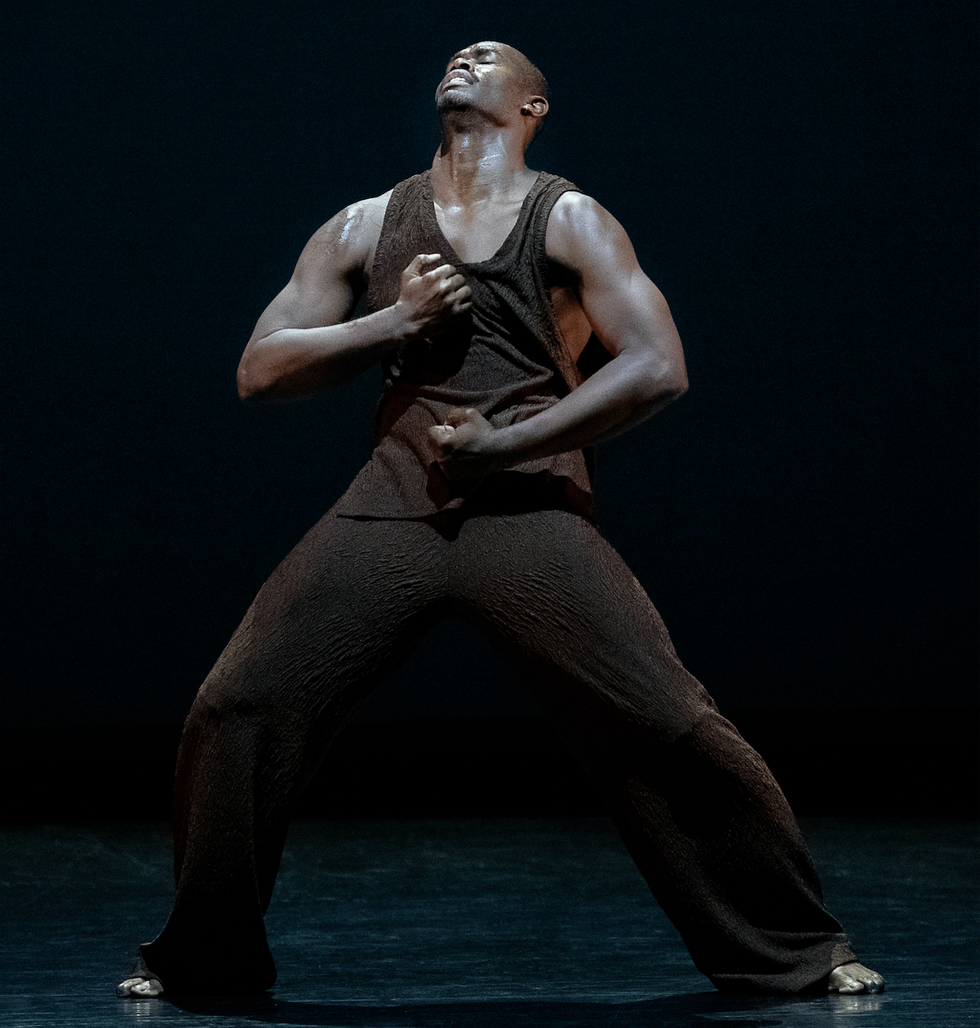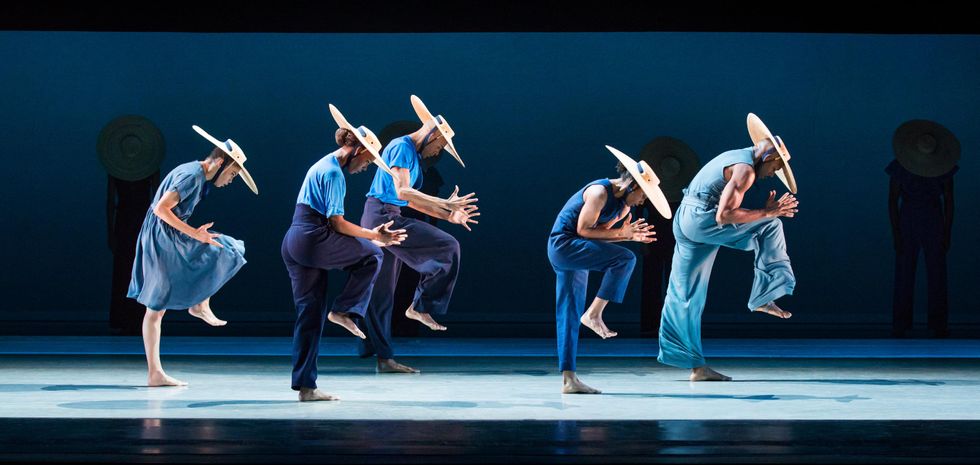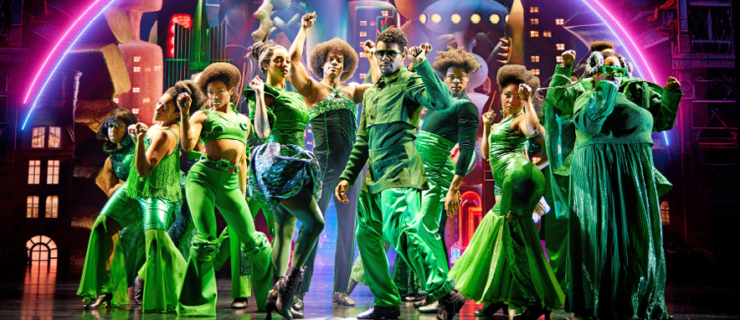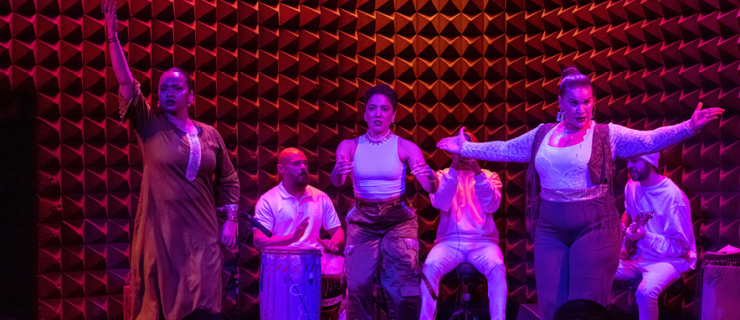Jamar Roberts’ Astonishing Dancing Is Matched By His Mesmerizing Choreography
Jamar Roberts stands still, all six feet and four inches of him, arms quietly at his sides. As a man’s voice is heard—the first two words of text are “Black is”—Roberts steps into a wide stance, arms held out to their fullest wingspan. He fills every inch of the stage with his presence. Then he begins to lower both arms, slowly curving them inward. As if by the flip of a switch, on the words “oh my god,” he flexes his wrists, twists his torso, and curves into a deep backbend. His body responds as if an electric current were going through it.
The dance is Morani/Mungu (Black Warrior/Black God), a solo he created for himself as part of last year’s Fall for Dance festival, commissioned by New York City Center. Fifteen minutes long, full of rises and falls, it is a killer, Roberts told me recently. “I hope I never have to dance it again,” he says.

Morani/Mungu (Black Warrior/Black God) Christopher Duggan, Courtesy New York City Center
A lot of these dynamics radiate from the power and malleability of his back. “That’s where the movement starts from, the intent of it,” says fellow Alvin Ailey American Dance Theater dancer Ghrai DeVore-Stokes. “Watching him is amazing, because you learn so much about yourself and about dance.”
But beyond all that, Roberts, and his choreography, gives the clear and deep impression that there is much happening beneath the surface. He has emerged, in the past two years, as a choreographic voice of uncommon force and originality. His work captures the spirit of our age, full of doubt, pain, but also grace. Two years ago he became resident choreographer at Ailey, where he has danced since 2002. More recently, he started a fellowship at NYU’s Center for Ballet and the Arts, and has commissions for Vail Dance Festival and New York City Ballet in the works. Even the pandemic hasn’t put a damper on his creativity. If anything, it has pushed it even further.
When he created Cooped, a solo for Works & Process Artists Virtual Commissions in May 2020, Roberts threw himself into the process of finding new ways to film movement with the best camera he had: his iPad. Despite no experience in film, he ended up creating something original, strangely detached from reality, disorienting.
“I think I used a lamp, an iPad, a yoga mat, some Scotch tape and a milk crate,” he says. Out of that and the sound of blaring bagpipes, he created a space outside of time, as well as a powerful image of the Black body in pain, trapped in a too-small, suffocating space, with no way out.
This ability to make something so visually complex and compelling out of just a few elements—sound, the body, a yoga mat—is something he associates with his difficult childhood, growing up with little money, a mother who struggled with addiction, a grandmother who wasn’t quite sure why he wanted to be a dancer. As a kid, he largely had to keep himself entertained. He would retreat into his own world and draw, or create little figures out of pieces of wire. Later, dance became a salvation, the thing that took him to a different place. “It reminds me of when people say that African Americans, throughout their entire journey, have been making something out of nothing,” he says. He has the patience, the focus and the imagination to make something new each time.
At Ailey, Roberts, 38, is known as a quiet person who keeps to himself. “When I see him walk into the studio, or just walking around, he looks like there’s something bubbling up,” says Ronald K. Brown, who has choreographed on him many times. “He’s brewing.” It can read as shyness, but his colleagues know better. “I think that’s where he lives, in that space within,” Robert Battle, artistic director of Ailey since 2011, says.
By the time Battle asked Roberts to become the company’s first official resident choreographer in 2019 (the expectation was that he would make a work per year for three years), he had been watching Roberts closely for a while. “Jamar never came to me and declared himself a choreographer,” Battle says. “But I had been watching him, being a voyeur, seeing him improvise little things. Sometimes you can just tell. Even just the way he interprets other people’s choreography told me something about his creativity.”
After seeing a piece Roberts made for Ailey II, Battle commissioned his first work for the main company in 2017. He also knew about Roberts’ other artistic pursuits, drawing and fashion design.
Roberts has left Ailey twice, once early on to pursue a degree in fashion design. (“I hated it. Sitting through lectures about how to make a Peter Pan collar, I really wasn’t into that,” he says.) It was during his second time away from Ailey, from 2011–12—he was burned-out, he says—that he discovered his love for choreography. It happened while he was teaching in the Miami studio of his longtime mentor and teacher Angel Fraser-Logan. (As an adolescent, he had studied dance with Logan at Dance Empire, as well as at New World School of the Arts.) He spent hours there making dances for the students and for friends in college nearby.
“It was a very intense and immersive kind of experience. And I started to notice that there was something there, something happening with the movement,” he says. After a year, feeling that he would have more opportunities to choreograph in New York City, he decided to go back to Ailey.
But it was his first dance for Ailey, Members Don’t Get Weary, that really set him on his current path. When it premiered in 2017, it looked like the creation of a much more veteran choreographer. Its intentions and emotions—conflict and pain, struggle and terror, the fatigue of hard work—felt distilled, reduced to their essence. “Like an alchemist, he got to the heart of the matter,” says Battle.

Members Don’t Get Weary Paul Kolnik, Courtesy AAADT
When Roberts started the piece, he had come in with an idea and an atmosphere. His choice of music (John Coltrane) and the costumes he had designed (plain work clothes) had already created a sense of time and place, “a space for the dancers to exist in,” says DeVore-Stokes. Once that space had been defined, the process of making the piece was one of exploration and filling in. “Whenever I go to make something, there’s a large area of unknown. I’m always throwing myself into a space where I don’t have the answer. I love doing the work to find the answers,” he says.
He goes through a similar process with the music he chooses. Roberts intentionally selects scores he is not only drawn to, but challenged by. When he first listened to the music for Members, the complexity and richness of Coltrane’s musical meanderings terrified him, he admits. “But, then you sit with it, something appears, whether it be big or small, and you keep pulling on that string.” In this case, pulling on the string means listening, intently, to all the nuances in the music, figuring out how they tie together, their energetic flow, finding a way to physicalize those connections.
Like Members, his other works have been set to jazz, including classic and bebop and avant-garde. But he came to jazz late. Roberts grew up listening to R&B and pop and alternative rock. However, when he started to think seriously about choreography, he felt that he needed to turn to music that gave him more space to explore. Pop was too easy. “I wanted to develop a more sophisticated ear, to invest in listening to more sounds.” Using classical music felt inauthentic. So he turned to jazz, America’s own classical idiom, rooted in African-American musical traditions. His understanding of jazz is something he has had to work at, he says. “I had to figure out how to do it—how to take myself there.” Expanding his musical palette still takes up a lot of his free time.
That musical understanding is central to his craft. When you watch him dance, or see others dance his work, it’s like seeing the notes travel through muscle and bone. “The way he hears music is beyond anything I’ve seen,” DeVore-Stokes says. “He’ll hear things that we didn’t even know were there.”
Roberts doesn’t seem interested in making slight, throwaway dances. “I wanted that piece to be about this duality of light and dark, what W.E.B. Du Bois called double consciousness,” he says of Morani/Mungu. “About being Black and being American, and this idea of always having to fight for your freedom and fight for your rights, even though you’re American.”

Struggle, and the pressure that builds up because of that struggle, is a powerful motor behind his creative process. But his dances are also full of mystery and abstraction. Nothing is spelled out. “He works as if he had a secret,” Brown says. In Roberts’ 2019 Ode, a response to the shootings of Black men and women, there were no obvious images of gun violence. And Morani/Mungu contains almost no literal references to the words in the text to which it is set, except when Roberts “marches,” on his knees, to the words “Black is marching in Alabama.” Even that is fleeting and easy to miss.
But as you watch one of his pieces you feel as if you have been on a voyage through Roberts’ mind, experiencing what this dancer—this idealized human—feels as he processes his thoughts: about Blackness, about America, about Coltrane, about rhythm, about the sound of Nina Simone’s fingers on the piano keys, about exhaustion, about hope.
Struggle lies both in the subject matter of his dances, which often touch on issues related to race, but also in the form of the dances themselves, the way they are constructed, the way the contrasts within them build tension and, eventually, release. “I think there’s a lot to learn there, a lot of beauty,” he says. He’s not content to simply convey meaning; form and craft are just as important.
It is part of what makes his dances, and his dancing, so potent. They feel lived in, and pregnant with meaning. Just as crucially, he is able to communicate those qualities to the dancers he works with. “When I’m in the studio with Jamar,” says DeVore-Stokes, “I feel like I’m doing work that’s really important and is going to push the field in a different direction.” Just which direction that will be is yet to be seen. As Battle says, “He’s just getting started.”




